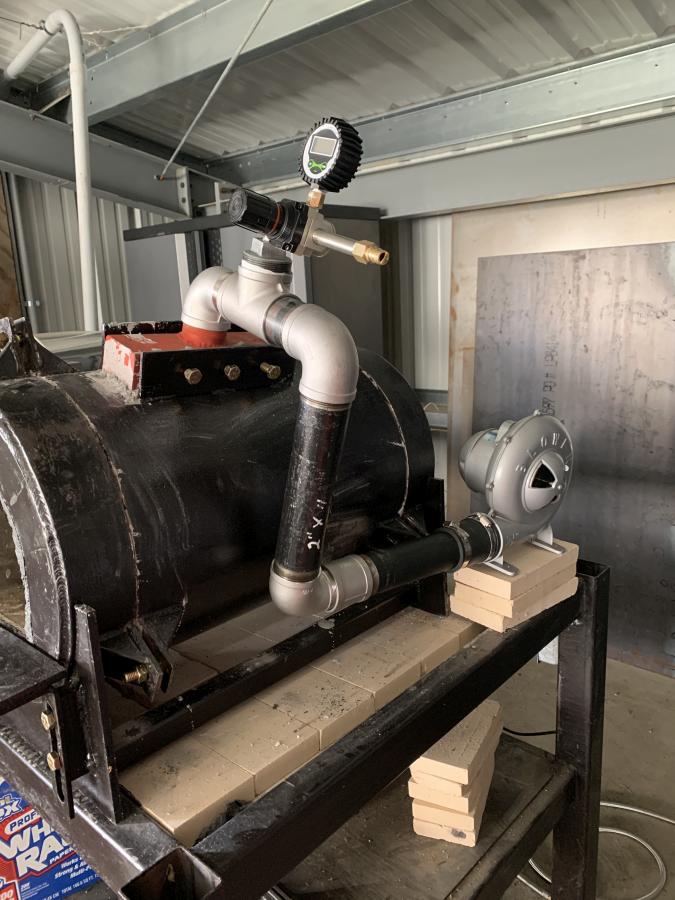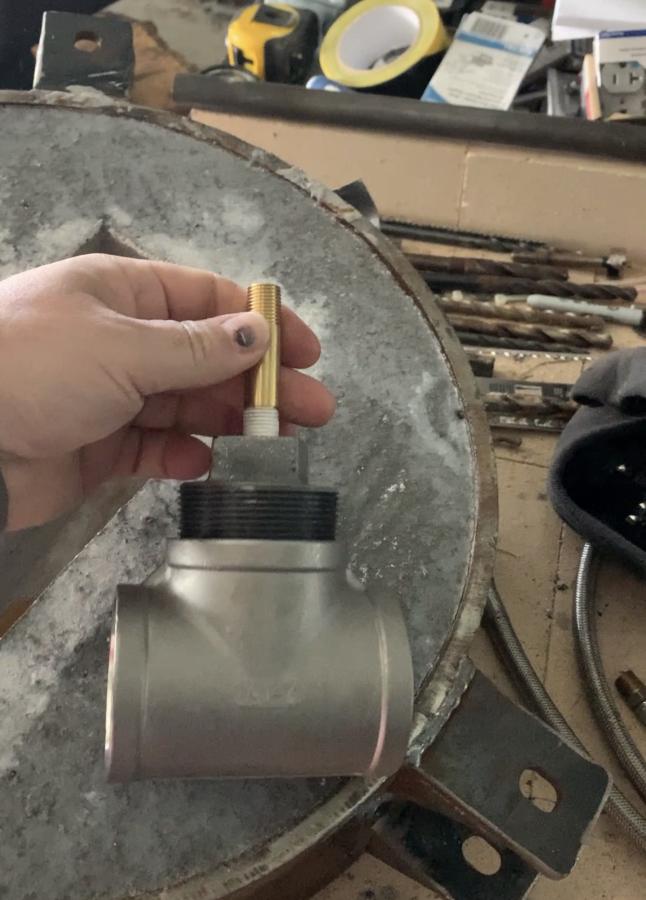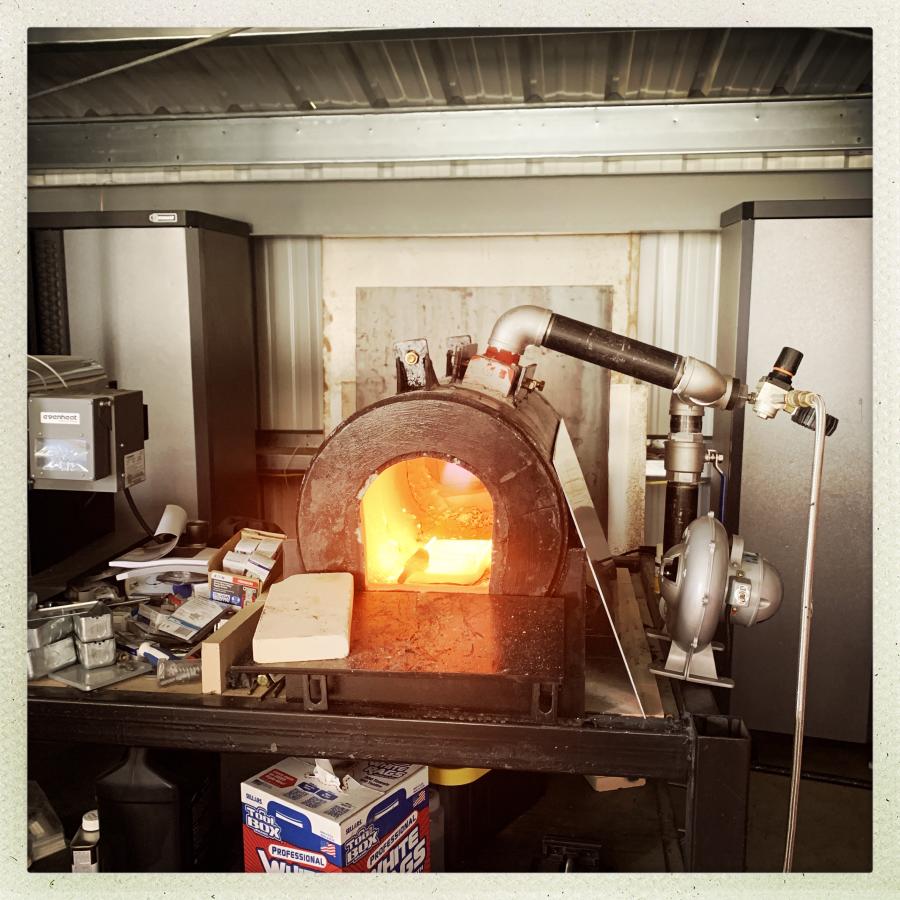Once the forge body is all assembled, the next problem is to see if it can get hot enough to weld in. The whole exercise is completely pointless if you can’t use the thing for its intended purpose.
Around about this point I began to worry about thermal mass. Anything you’re heating up that’s not your work-piece is wasted heat, sucked of the interior of the forge by Maxwell’s demon. But we’re in the land of unknowns, here: it may be that there’s too much cement, or something like that. There’s a lot of cement. Here’s another thing: there’s always still moisture in the cement so when you light it, a lot of heat is carried away in the form of steam until the cement is dry. There are a lot of variables and the only thing we can do is try:

There have been several versions of this, and there may be another someday. The current version has the injector moved down to be next to the fan.
Let’s look at this in reverse order:
The fan – that’s a classic blacksmith’s electric blower fan. It makes a good solid wind, suitable for blacksmithing. I figured the adapter, which is a pipe repair collar I managed to slide over both ends; it works great. Then, some plumbing. At the top is the propane injector. The injector is nothing magical – it just dumps propane into the air-flow headed toward the ribbon burner. Plenty of mixing happens up on the red plenum on top of the burner, but some forge-builders feel that the injector jet matters, or the mixing matters. Experimentally, I have moved the injector down near the fan (no difference, but I like having it away from the upper part of the forge anyway) It’s pretty simple: if there’s too much propane, you can smell propane, which means WARNING WARNING WARNING time to re-figure things. If the burner hiccups then it means there’s not enough air. If it goes out, it means there’s too much air. Once you find a combination of controls that works, you leave it alone.

Later, I threaded the inside of the cap, too, so a nipple could be threaded into the reverse end, with an end-cap on it with a couple of holes drilled into it. The forge was running too rich and I was hoping I could get enough back-pressure on the line that the pressure gauge would work. It didn’t. So, I have no idea what propane pressure I am using though it seems to me to be less than my old forge used.
My old forge had “venturi style” burners – burners where the force of the propane jetting into a semi-enclosed place, causes the air to mix for ignition. They burn very cleanly and hot, but they’re not even in the ballpark of a “blown” forge with a fan providing 3-4 times as much air as the venturis. In principle, ribbon burner forges can run much more efficiently. They don’t, however, run cooler.
For curiosity’s sake I made a small variety of injectors, and tried them, and as far as I can tell it makes no difference. Let’s hear it for science!
At the right end of the regulator cluster you can see a weird thingie. That’s a quick-connect propane connector; it’s pretty neat – you can disconnect it while the propane is on full pressure and it closes the line. It leaks a little but, seriously, if you need an emergency one-hand disconnect, it’s great. It also means you can throw the disconnected line onto the floor (where it’s cool) away from the action. Seems like $35 well spent. None of the propane lines need to be able to hold high pressure once you’re past the quick connect, though I’ve bubble-tested everything and it’s all tight.
Time to light it:
The usual process for lighting a forge is to light a paper towel and throw that into the maw, then hit the gas. So, I did that. Then, I remembered that I hadn’t turned the air blower on, yet, so there was probably propane building up in the line, waiting to eventually reach the flames and explode. So, I turned on the fan.
Once had that all sorted out, I was able to twiddle the various air/fuel settings and get some pretty pretty flames. Then, the question was “will the forge reach welding temperature?”
There were some other problems. Because it’s pressurized, the area in front of the maw is a sort of death-beam of heat. If you reach to get something, even with 3-foot tongs, you’ll burn all the air off your arm if you’re not wearing gloves. It’s interesting because that forces the user to be very judicious about where they place objects and how they will be able to grab them quickly with tongs. It’s challenges layered on challenges.
I made up a chunk of wire rope and tried to weld it: no dice. That depressed me. But there was still a lot of steam coming off the forge body. And, it was “singing” – a kind of high pitched pulsing scream. I reasoned (correctly) that it might be a result of resonance because the fuel/air mix was not burning evenly, so I re-plumbed the whole feed system to place the injector down near the fan. Problem solved. I sounded creepy and “creepy” is not the vibe I wanted.
 That bright yellow heat is what you want! Yesterday, I made up a block of 1095 and 15n20 alternating strips, tack welded them together, and forge-welded them into a pretty nice-looking bar, which I then twisted and squared up. It’s in the annealing bin right now, but today I will take it over to Mr Happy Dancing Bandsaw and see if the welds look clean. If they are, I will section it up and make some knives out of it!
That bright yellow heat is what you want! Yesterday, I made up a block of 1095 and 15n20 alternating strips, tack welded them together, and forge-welded them into a pretty nice-looking bar, which I then twisted and squared up. It’s in the annealing bin right now, but today I will take it over to Mr Happy Dancing Bandsaw and see if the welds look clean. If they are, I will section it up and make some knives out of it!
There’s still a bit of work to do on the thing. You can see a plate of aluminum resting against the right side. I plan to make some stand-offs (center-tapped) and weld them to the side, then mount the aluminum to serve as a heat shield. This thing badly needs an exhaust hood – it projects unbearable heat straight out the front. For now, I’m happy and I can forge things again!
Instagram has a filter that adds fire to images or video. Naturally, I thought “what would it do with something that was really on fire already?”

Look at the the way the propane feed line is burning! Holy crap! RUN!

Uploading the video to youtube was a fountain of irritation. Needless to say, youtube detected patterns in the music I used and sent me a message to the effect “assclam has a copyright claim on this music, continue?” Yes. “They will be able to monetize your video, continue?” So I had to file a signed statement to the effect that Carmina Burana, which was written in 1939, is out of copyright. The video will probably be pulled (I know the performance is still under its copyright, but I’m pretty sure some internet assclam does not hold the copyright to that performance, Warner Brothers does because Warner Brothers owns all the music.) Someone please explain to me again how capitalism helps make our world better by giving everyone access to all the music?

Just thinking of potential failure modes, I’m curious to know what would happen with the propane if the blower fails? Does it keep burning in the forge? Or out the blower? Or stop burning and accumulate in the room? The first one is not a problem because you’d simply have a low temperature flame but the other 2 would not be good options.
That’s kind of an interesting problem. You want to keep as much heat in the forge as possible, but since you are pumping air into it, air containing that heat will leave. Trying to recycling the hot air wouldn’t help much, as the design is consuming the oxygen in it (assuming you could even find a blower which could handle the heat). You could probably calculate the volume of air you are pumping into the forge, and how much is exiting through the maw. If you pulled the hot air off the top of the maw (assuming it could be done safely) you would probably reduce the heat at the front of the forge. Which would reduce the working space and requiring items to be placed further in. I’m not certain that would help. Of course, I’m just spit-balling, there are probably solutions I’m not thinking of.
Maybe some sort of air curtain a few centimeters in front of the maw would deflect the hot air away from the hearth, keeping the pressure a little higher in the forge and keeping the hearth area a bit cooler.
That wouldn’t stop the IR though, and that could also be a problem.
I first thought that the final photo with the Instagram filter was an overlayed thermal camera shot. Not for long, it’s clear that the heat is in the wrong place. I suspect that a thermal camera would just register the opening and everything around it would be overwhelmed by that heat.
Er, that’s the exact opposite of Maxwell’s demon: https://en.wikipedia.org/wiki/Maxwell%27s_demon
It might depend on the size and shape of the pieces you want to heat and weld, but how about induction heating?
@2:
The usual trick is to use a counter-flow heat exchanger to transfer the heat (including the latent heat of evaporation of the included water vapour) from the exhaust gases (which are then vented) to the fresh incoming gas/air feed. They are what is used in condensing boilers for example giving common thermal efficiencies around 90% and up to 98% claimed.
A door seems like a logical addition. If it was on a lift hinge you could also use it as a heat shield by only opening it a few inches.
Chuffed to bits for you!
Yeah that last photo says RUN! loud and clear.
This is how the test bar came out: all the welds are solid. I pretty much already knew that when I was able to twist it, but it’s always good to be sure. I gave one piece a mild etch for the heck of it.
Tethys@#6:
A door seems like a logical addition. If it was on a lift hinge you could also use it as a heat shield by only opening it a few inches.
I’m probably going to do a horizontal sliding door, which means I need to assemble some runners and pulleys and whatnot. Always more stuff to do!
rsmith@#4:
It might depend on the size and shape of the pieces you want to heat and weld, but how about induction heating?
I’ve thought about it. The powerful systems that are able to do rapid heating are pretty expensive and use a lot of power. Mostly, though, it doesn’t suit my style of working. Yet.
Sunday Afternoon@#3:
Er, that’s the exact opposite of Maxwell’s demon
Arrgh!
Maybe I was writing about the republican version of Maxwell’s demon…?
flex@#2:
Maybe some sort of air curtain a few centimeters in front of the maw would deflect the hot air away from the hearth, keeping the pressure a little higher in the forge and keeping the hearth area a bit cooler.
I’ve sort of set that up and it sort of works: I have a big fan behind my back, blowing heat away from the forge and into the back of the building (where it goes up through a chimney) It’s still not great but it’s an improvement. A vent hood over the forge will also help a lot. I just have to build one.
Jean@#1:
I’m curious to know what would happen with the propane if the blower fails? Does it keep burning in the forge? Or out the blower? Or stop burning and accumulate in the room?
Well, you never leave your forge running unattended. So, that’s one thing: if the power fails, you cut off the gas at the master valve and it’ll clear the system.
There’s a potential that the gas in the pipe and ribbon burner plenum might burn back, in which case I guess there’d be a “pop” but it wouldn’t have any pressure behind it so it probably would be alright. It might result in some soiled underpants, though.
I have thought about putting an uninterruptable power supply under the fan, but it seems like that’s probably not necessary.
Marcus @9
Yes, it’s probably a good idea to keep the door well away from those components on the top.
Is it just me, or have you built an enormous forge? A good vent hood system is another thing I am glad to hear you plan to add. I would think it would be easier to source one than build it from scratch, but I don’t have a shop full of fun power tools. ;)
I’m familiar with burn out ovens that have the vertical door I mentioned. They are mounted on very well balanced spring loaded (?) hinges, and can be opened and positioned with one hand while the other is busy holding a red hot piece of metal. Photo of oven below, hopefully.
https://www.ottofrei.com/images/122.370_zoom.jpg
——
I picture a sliding forge door mounted on something like barn door hardware, so you can similarly slide it open it with one hand.